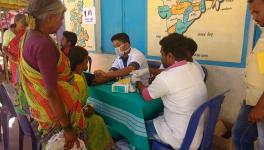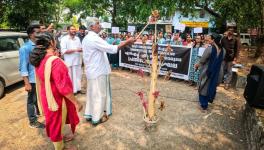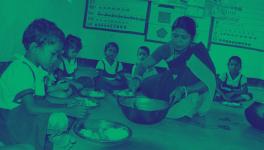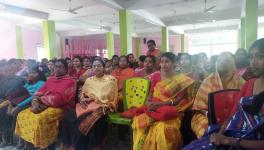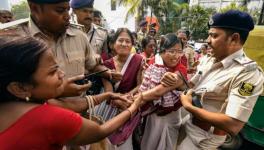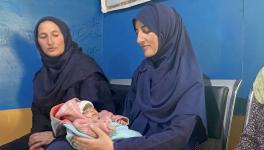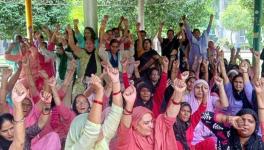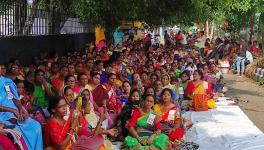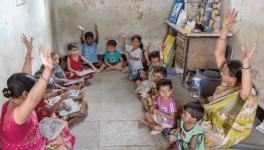Anganwadi Workers are Right: They Need More Money
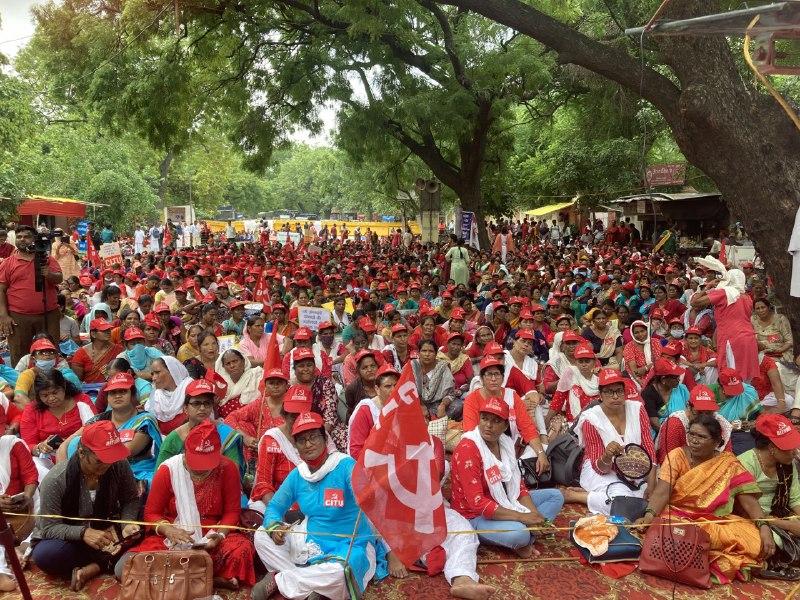
Anganwadi caregivers from across the country reach the national capital on Tuesday. Image clicked by Ronak Chhabra
Anganwadi workers, who gathered in Delhi from various parts of the country in protest as part of their Adhikar Mahapadav, have rightly emphasised the need for substantially more funds for wages, gratuity, social security etc., and for the urgent nutrition requirements of women and children.
The word Anganwadi has become almost synonymous with the biggest nutrition program in India for children up to six and pregnant and lactating mothers. Known earlier as ICDS or Anganwadi services, this scheme has been used to provide nutrition, pre-school education and related services. During the COVID-19 pandemic, the women workers also provided valuable healthcare services.
In 2021, the government added three more nutrition and childcare programs to this scheme and renamed it Saksham Anganwadi Scheme and Poshan-2. In recent years, there have been several recommendations to improve the infrastructure and facilities, create nearly 2 lakh enhanced centres, make substantial improvements in pre-school education and launch a special effort to improve nutrition in over 100 so-called aspirational districts.
At the same time, the demands of Anganwadi workers, who are often denied even the minimum legal wage, have been gathering strength. What is more, several vacant posts have to be filled.
All this requires funds, but unfortunately, the government has not provided these. The expenditure and allocation trend for the scheme is stagnant, but if we provide for inflation, then in real terms, there has been a decline. In such a situation, how can the government make the improvements it announces from time to time, and how can it meet the legitimate aspirations of Anganwadi workers for better wages and gratuity?
Comparing expenditure and allocations over the years has become difficult because of the merger of various schemes and other policy changes. However, the Centre for Budget Governance and Accountability has made an effort by re-calculating the expenditure of earlier years—mainly adding the expense of recently merged schemes.
The picture of expenditure and allocations for Saksham Anganwadi and Poshan 2 that emerges from this analysis is listed below.
In 2015-16, the actual expenditure was Rs. 16,097 crores, in 2016-17 the actual expenditure was Rs. 15,239 crores, and in 2017-18 the actual expenditure was Rs. 16,548 crores. In the two following years, this figure rose to Rs. 19,672 crores and Rs. 18,927 crores in 2019-20. But the budget estimate in 2020-21 was Rs. 24,557 crores, which was revised to Rs. 17,917 crore. Similarly, in the financial year 2021-22, the Budget Estimate was Rs. 20,105 crores, which rose by an insignificant amount to Rs. 20,200. And finally, the FY 2022-23 Budget Estimate was Rs. 20,263 crores.
This data reveals that the only recent year when the original budget allocation was significantly increased was 2020-21, but even this year, while preparing the Revised Estimate, there was a massive cut in the allocation. So big was this cut (Rs. 6,640 crores) that the revised estimate this year is lower than the actual expenditure made since 2018-19. Even worse, when we compare the Budget Estimates since 2020-21, the allocation has stagnated in the last two years—and is substantially lowering.
In 2020-21, the 15th Finance Commission had recommended in its interim report just for this year that a grant of Rs. 7,735 crores should be made to states for strengthening supplementary nutrition under Aanganwadi, but the government did not accept this. In its final report, the Finance Commission also dropped this specific budgetary recommendation while talking in general about strengthening Aanganwadi.
A question that arises is—how can the improvements in nutrition and justice for workers be achieved in such a situation of decline in real terms of funds availability? The sad reality is that what to talk of improvements, the nutrition coverage is declining. Recent reports have pointed how that the number of supplementary nutrition program beneficiaries has fallen from 10.2 crore in 2016 to 8.6 crore in 2020, a 15% fall. In 2019, only 46% of pregnant and lactating mothers received take-home rations to which they are entitled, although 78% were enrolled. Less than half of eligible children were covered. The coverage remains low even in urban areas because of the higher costs of building or renting centres here.
In March 2021, 71,801 posts of Anganwadi workers were vacant. Around this time, nearly 12,000 sanctioned centres were not operational, while in several of the more remote hamlets, had not even been sanctioned yet. At the level of supervisory staff, the vacant posts are higher, leading to a decline in performance.
Around a year ago, reports indicated how nearly 30% of posts of Child Development Project Officers and 28% of lady supervisors were vacant. After 2017, the salary burden shifted more to state governments which they have found difficult to cope with given their resource constraints. The deficient honorarium for workers and many unmet needs of the program make it challenging to keep the program running.
To meet the pressing needs of workers and children’s nutrition and early education, the government has to make much more funds available for this vital program. Child malnutrition is among the highest in our country, so we cannot afford our most crucial child and mother nutrition program to suffer from a lack of resources. The importance of early or pre-school education is also now increasingly realised. The needs of Anganwadi workers who have been given these essential responsibilities cannot be neglected if this situation has to be reversed. If workers cannot meet the basic needs of their own families, or are demoralised, how will they give their best to their work?
Hence funds for this important program should be significantly increased for both components—improving nutrition and basic infrastructure and arranging better remuneration, gratuity and social security for Anganwadi workers all over the country.
The writer is honorary convener, Campaign to Save Earth Now. His recent books include A Day in 2071, Planet in Peril and Man over Machine. The views are personal.
Get the latest reports & analysis with people's perspective on Protests, movements & deep analytical videos, discussions of the current affairs in your Telegram app. Subscribe to NewsClick's Telegram channel & get Real-Time updates on stories, as they get published on our website.









